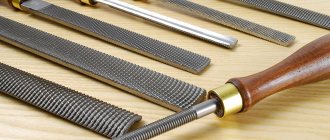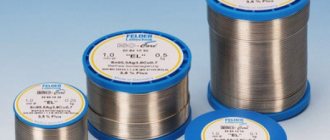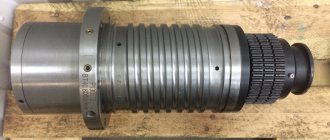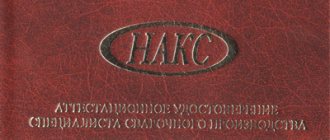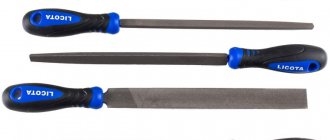The principle of semiconductor control of electric current was known at the beginning of the twentieth century. Even though electronics engineers knew how a transistor worked, they continued to design devices based on vacuum tubes. The reason for such distrust of semiconductor triodes was the imperfection of the first point-point transistors. The family of germanium transistors did not have stable characteristics and were highly dependent on temperature conditions.
Monolithic silicon transistors began to seriously compete with vacuum tubes only in the late 50s. Since that time, the electronics industry began to develop rapidly, and compact semiconductor triodes actively replaced energy-intensive lamps from electronic device circuits. With the advent of integrated circuits, where the number of transistors can reach billions, semiconductor electronics has won a landslide victory in the fight to miniaturize devices.
What is a transistor?
In its modern meaning, a transistor is a semiconductor radio element designed to change the parameters of an electric current and control it. A conventional semiconductor triode has three terminals: a base, which receives control signals, an emitter, and a collector. There are also high power composite transistors.
The size scale of semiconductor devices is striking - from several nanometers (unpackaged elements used in microcircuits) to centimeters in diameter for high-power transistors intended for power plants and industrial equipment. Reverse voltages of industrial triodes can reach up to 1000 V.
Device
Structurally, the triode consists of semiconductor layers enclosed in a housing. Semiconductors are materials based on silicon, germanium, gallium arsenide and other chemical elements. Today, research is being conducted to prepare certain types of polymers, and even carbon nanotubes, for the role of semiconductor materials. Apparently in the near future we will learn about new properties of graphene field-effect transistors.
Previously, semiconductor crystals were located in metal cases in the form of caps with three legs. This design was typical for point-point transistors.
Today, the designs of most flat, including silicon semiconductor devices are made on the basis of a single crystal doped in certain parts. They are pressed into plastic, metal-glass or metal-ceramic cases. Some of them have protruding metal plates for heat dissipation, which are attached to the radiators.
The electrodes of modern transistors are arranged in one row. This arrangement of the legs is convenient for automatic board assembly. The terminals are not marked on the housings. The type of electrode is determined from reference books or by measurements.
For transistors, semiconductor crystals with different structures, such as pnp or npn, are used. They differ in the polarity of the voltage on the electrodes.
Schematically, the structure of a transistor can be represented as two semiconductor diodes separated by an additional layer. (See Figure 1). It is the presence of this layer that allows you to control the conductivity of the semiconductor triode.
Rice. 1. Structure of transistors
Figure 1 schematically shows the structure of bipolar triodes. There is also a class of field-effect transistors, which will be discussed below.
Basic operating principle
At rest, no current flows between the collector and emitter of a bipolar triode. Electric current is prevented by the resistance of the emitter junction, which arises as a result of the interaction of the layers. To turn on the transistor, you need to apply a small voltage to its base.
Figure 2 shows a diagram explaining the working principle of a triode.
Rice. 2. Operating principle
By controlling the base currents, you can turn the device on and off. If an analog signal is applied to the base, it will change the amplitude of the output currents. In this case, the output signal will exactly repeat the oscillation frequency at the base electrode. In other words, the electrical signal received at the input will be amplified.
Thus, semiconductor triodes can operate in electronic switch mode or in input signal amplification mode.
The operation of the device in electronic key mode can be understood from Figure 3.
Rice. 3. Triode in switch mode
Designation on diagrams
The generally accepted designation is “VT” or “Q” , followed by a positional index. For example, VT 3. On earlier diagrams you can find outdated designations: “T”, “PP” or “PT”. The transistor is depicted as symbolic lines indicating the corresponding electrodes, circled or not. The direction of current in the emitter is indicated by an arrow.
Figure 4 shows a ULF circuit in which transistors are designated in a new way, and Figure 5 shows schematic images of different types of field-effect transistors.
Rice. 4. Example of a ULF circuit using triodes
Characteristics
Since semiconductor triodes (transistors) are made of semiconductor, their operation is also affected by the environment. For example, when the ambient temperature changes, the transistor may introduce nonlinear distortions into the output signal. This is combatted with the help of thermal post-stabilization circuits, which allow the operation of the transistor to be stabilized at high temperatures.
Transistors also have current-voltage characteristics (volt-ampere characteristics), which, unlike vacuum technology, quickly go into saturation.
All transistors have the following parameters:
Operating modes
In general, several operating modes can be distinguished:
Types of transistors
Based on their operating principle and structure, semiconductor triodes are distinguished:
- field;
- bipolar;
- combined.
These transistors perform the same functions, but there are differences in the principle of their operation.
Field
This type of triode is also called unipolar, due to its electrical properties - they carry current of only one polarity. Based on their structure and type of control, these devices are divided into 3 types:
- Transistors with control pn junction (Fig. 6).
- With an insulated gate (available with a built-in or induced channel).
- MIS, with structure: metal-dielectric-conductor.
A distinctive feature of an insulated gate is the presence of a dielectric between it and the channel.
Parts are very sensitive to static electricity.
Circuits of field triodes are shown in Figure 5.
Rice. 5. Field effect transistors
Rice. 6. Photo of a real field-effect triode
Pay attention to the names of the electrodes: drain, source and gate.
Field effect transistors consume very little power. They can work for more than a year on a small battery or rechargeable battery. Therefore, they are widely used in modern electronic devices such as remote controls, mobile gadgets, etc.
Bipolar
Much has been said about this type of transistor in the subsection “Basic operating principle.” Let us only note that the device received the name “Bipolar” because of its ability to pass charges of opposite signs through one channel. Their feature is low output impedance.
Transistors amplify signals and act as switching devices. A fairly powerful load can be connected to the collector circuit. Due to the high collector current, the load resistance can be reduced.
Let's look at the structure and principle of operation in more detail below.
Combined
In order to achieve certain electrical parameters from the use of one discrete element, transistor developers invent combined designs. Among them are:
- bipolar transistors with embedded resistors and their circuit;
- combinations of two triodes (same or different structures) in one package;
- lambda diodes - a combination of two field-effect triodes forming a section with negative resistance;
- designs in which a field-effect triode with an insulated gate controls a bipolar triode (used to control electric motors).
Combined transistors are, in fact, an elementary microcircuit in one package.
Literature on electronics
The science that studies transistors and other devices is called electronics. Its entire section is devoted to semiconductor devices. If you are interested in getting more information about the operation of transistors, you can read the following books on this topic:
- Digital Circuit Design and Computer Architecture - David M.
- OS. Design and implementation - Andrew T.
- Power electronics for amateurs and professionals - B. Yu. Semenov.
These books describe various programmable electronics tools. Of course, all programmable circuits are based on transistors. Thanks to these books, you will not only gain new knowledge about transistors, but also skills that may bring you income.
Now you know how transistors work and where they are used in life. If you are interested in this topic, continue to study it, because progress does not stand still, and all technical devices are constantly being improved. In this matter, it is very important to keep up with the times. I wish you success!
How does a bipolar transistor work? Instructions for dummies
The operation of bipolar transistors is based on the properties of semiconductors and their combinations. To understand the principle of operation of triodes, let's understand the behavior of semiconductors in electrical circuits.
Semiconductors.
Some crystals, such as silicon, germanium, etc., are dielectrics. But they have one feature - if you add certain impurities, they become conductors with special properties.
Some additives (donors) lead to the appearance of free electrons, while others (acceptors) create “holes”.
If, for example, silicon is doped with phosphorus (donor), we obtain a semiconductor with an excess of electrons (n-Si structure). By adding boron (an acceptor), the doped silicon will become a hole-conducting semiconductor (p-Si), that is, its structure will be dominated by positively charged ions.
One-way conduction.
Let's conduct a thought experiment: connect two different types of semiconductors to a power source and supply current to our design. Something unexpected will happen. If you connect the negative wire to an n-type crystal, the circuit will be completed. However, when we reverse the polarity, there will be no electricity in the circuit. Why is this happening?
As a result of connecting crystals with different types of conductivity, a region with a pn junction is formed between them. Some electrons (charge carriers) from an n-type crystal will flow into a crystal with hole conductivity and recombine holes in the contact zone.
As a result, uncompensated charges arise: in the n-type region - from negative ions, and in the p-type region from positive ions. The potential difference reaches values from 0.3 to 0.6 V.
The relationship between voltage and impurity concentration can be expressed by the formula:
φ= VT * ln (Nn * Np)/n2i, where
VT is the value of the thermodynamic stress, Nn and Np are the concentration of electrons and holes, respectively, and ni denotes the intrinsic concentration.
When connecting a plus to a p-conductor and a minus to an n-type semiconductor, the electric charges will overcome the barrier, since their movement will be directed against the electric field inside the pn junction. In this case, the transition is open. But if the poles are reversed, the transition will be closed. Hence the conclusion: the pn junction forms one-way conductivity. This property is used in the design of diodes.
From diode to transistor.
Let's complicate the experiment. Let's add another layer between two semiconductors with the same structures. For example, between p-type silicon wafers we insert a conductivity layer (n-Si). It is not difficult to guess what will happen in the contact zones. By analogy with the process described above, regions with pn junctions are formed, which will block the movement of electrical charges between the emitter and collector, regardless of the polarity of the current.
The most interesting thing will happen when we apply a slight voltage to the layer (base). In our case, we will apply a current with a negative sign. As in the case of a diode, an emitter-base circuit is formed through which current will flow. At the same time, the layer will begin to become saturated with holes, which will lead to hole conduction between the emitter and collector.
Look at Figure 7. It shows that positive ions have filled the entire space of our conditional structure and now nothing interferes with the conduction of current. We have obtained a visual model of a bipolar transistor with a pnp structure.
Rice. 7. Principle of operation of the triode
When the base is de-energized, the transistor very quickly returns to its original state and the collector junction closes.
The device can also operate in amplification mode.
The collector current is directly proportional to the base current: Iк = ß*IB , where ß is the current gain, IB is the base current.
If you change the value of the control current, the intensity of hole formation on the base will change, which will entail a proportional change in the amplitude of the output voltage, while maintaining the signal frequency. This principle is used to amplify signals.
By applying weak pulses to the base, at the output we get the same amplification frequency, but with a much larger amplitude (set by the voltage applied to the collector-emitter circuit).
NPN transistors work in a similar way. Only the polarity of the voltages changes. Devices with NPN structure have direct conductivity. PNP type transistors have reverse conductivity.
It remains to add that the semiconductor crystal reacts in a similar way to the ultraviolet spectrum of light. By turning the photon flow on and off, or adjusting its intensity, you can control the operation of a triode or change the resistance of a semiconductor resistor.
Bipolar transistor connection circuits
Circuit designers use the following connection schemes: with a common base, common emitter electrodes, and connection with a common collector (Fig. 8).
Rice. 8. Connection diagrams for bipolar transistors
Amplifiers with a common base are characterized by:
- low input impedance, which does not exceed 100 Ohms;
- good temperature properties and frequency characteristics of the triode;
- high permissible voltage;
- two different power sources are required.
Common emitter circuits have:
- high current and voltage gain;
- low power gain;
- inversion of the output voltage relative to the input.
With this connection, one power source is sufficient.
The connection diagram based on the “common collector” principle provides:
- high input and low output resistance;
- low voltage gain factor (< 1).
Operating principle of the device
A transistor is a semiconductor device designed to amplify an electrical signal. Thanks to the special structure of crystal lattices and semiconductor properties, this device is able to increase the amplitude of the flowing current .
Semiconductors are substances that are capable of conducting current and also preventing its passage. Their most prominent representatives are silicon and germanium. There are two types of semiconductors:
- Electronic.
- Hole.
In semiconductors, electric current occurs due to a lack or excess of free electrons. For example, the crystal lattice of an atom consists of three electrons. However, if you introduce an atom consisting of four electrons into this substance, one will be extra. It is a free electron. Accordingly, the more such electrons, the closer this substance is to a metal in its properties. This means that the current conductivity is greater. Such semiconductors are called electronic .
Now let's talk about hole ones. To create them, atoms of another substance are introduced into a substance, the crystal lattice of which contains more atoms. Accordingly, there are fewer electrons in our semiconductor. Vacant places for electrons are formed. Valence bonds will be destroyed as electrons strive to occupy these vacant positions. Further, we will call them holes.
Electrons constantly strive to occupy a hole and, starting to move, form a new hole. Absolutely all electrons exhibit this behavior. They move in the semiconductor, which means current begins to flow . Such semiconductors are called hole semiconductors.
Thus, by introducing a deficiency or excess of electrons into silicon or germanium, we promote their movement. This produces a current. Transistors consist of connections of these semiconductors according to a certain principle. With their help, you can control flowing currents and other parameters of electrical signals.
How does a field effect transistor work? Explanation for dummies
The structure of a field-effect transistor differs from a bipolar one in that the current in it does not cross the pn junction zone. The charges move through a controlled area called the gate. The gate throughput is controlled by voltage.
The space of the pn zone decreases or increases under the influence of the electric field (see Fig. 9). The number of free charge carriers changes accordingly - from complete destruction to extreme saturation. As a result of this effect on the gate, the current at the drain electrodes (contacts that output the processed current) is regulated. The incoming current flows through the source contacts.
Figure 9. Field-effect transistor with pn junction
Field triodes with a built-in and induced channel operate on a similar principle. You saw their diagrams in Figure 5.
Field-effect transistor connection circuits
In practice, connection diagrams are used by analogy with a bipolar triode:
- with a common source - produces a large gain in current and power;
- common gate circuits provide low input impedance and low gain (has limited use);
- common-drain circuits that operate in the same way as common-emitter circuits.
Figure 10 shows various connection schemes.
Rice. 10. Image of field triode connection diagrams
Almost every circuit is capable of operating at very low input voltages.
Marking irfz44n
The prefix irf indicates that the devices are produced at enterprises belonging to the International Rectifier company (USA). 14 years ago, its employees sold their manufacturing technology to Vishay Intertechnology, and 8 years later, IR joined Infineon Technologies. Today, parts with the same prefix in the name are produced by a number of other independent enterprises.
Some technical descriptions of the device contain the symbols PbF at the end of the marking, which means plumbum free - a lead-free method of producing transistors. It is becoming popular in many countries, since many chemical compounds harmful to the environment and human health are currently prohibited for use.
The original datasheet mentions the proprietary HEXFET production technology created by International Rectifier Corporation. Thanks to it, the resistance of electronic parts and the heating temperature during their operation are seriously reduced. It also makes the use of a radiator-cooler unnecessary.
The IRFZ44N from the IR manufacturer, having a HEXFET structure, has the lowest drain-source resistance of 17.5 mOhm. In the technical description for these devices there is a Power MOSFET mark. It means that these transistors are powerful semiconductor devices.
Adviсe
- There are many ways to determine a malfunction, but first you need to understand the structure of the element itself and clearly understand the design features.
- The choice of device for testing is an important point regarding the quality of the result. Therefore, if you lack experience, you should not limit yourself to improvised means.
- When carrying out the test, you should clearly understand the reasons for the failure of the tested part, so as not to return over time to the same state of failure of household electrical appliances.
Device and principle of operation
A transistor is an electronic semiconductor consisting of 3 electrodes, one of which is the control one. A bipolar type transistor differs from a polar one in the presence of 2 types of charge carriers (negative and positive).
Negative charges are electrons that are released from the outer shell of the crystal lattice. A positive type of charge, or hole, is formed at the site of the released electron.
The design of a bipolar transistor (BT) is quite simple, despite its versatility. It consists of 3 conductor-type layers: emitter (E), base (B) and collector (K).
An emitter (from the Latin "to release") is a type of semiconductor junction whose main function is to inject charges into the base. The collector (from the Latin “collector”) serves to receive emitter charges. The base is the control electrode.
The emitter and collector layers are almost identical, but they differ in the degree of addition of impurities to improve the characteristics of the PCB. Adding impurities is called doping. For the collector layer (CL), doping is weakly expressed to increase the collector voltage (Uc). The emitter semiconductor layer is heavily doped in order to increase the reverse permissible breakdown U and improve the injection of carriers into the base layer (the current transfer coefficient - Kt increases). The base layer is lightly doped to provide greater resistance (R).
The junction between base and emitter is smaller in area than KB. Thanks to the difference in areas, the CT improves. When the PP is operating, the K-B junction is switched on with a reverse bias to release the bulk of the amount of heat Q, which is dissipated and provides better cooling of the crystal.
The performance of BT depends on the thickness of the base layer (BL). This dependence is a quantity that varies in inverse proportion. Less thickness means faster performance. This dependence is related to the time of flight of charge carriers. However, this reduces Uk.
A strong current flows between the emitter and K, called current K (Ik). A small current flows between E and B - current B (Ib), which is used for control. When Ib changes, Ik will change.
The transistor has two pn junctions: E-B and K-B. In the active mode, E-B is connected with a forward bias, and K-B is connected with a reverse bias. Since the E-B transition is in the open state, negative charges (electrons) flow into B. After this, they partially recombine with holes. However, most of the electrons reach the B-B due to the low legitimacy and thickness of the B.
In BS, electrons are minority charge carriers, and the electromagnetic field helps them overcome the Q-B transition. As Ib increases, the opening of E-B will expand and more electrons will flow between E and K. In this case, a significant amplification of the low amplitude signal will occur, since Ik is greater than Ib.
Watch this video on YouTube
In order to more easily understand the physical meaning of the operation of a bipolar transistor, you need to associate it with a clear example. It must be assumed that the pump for pumping water is the power source, the water tap is the transistor, the water is Ik, the degree of rotation of the tap handle is Ib. To increase the pressure, you need to turn the tap a little - perform a control action. Based on the example, we can conclude that the PP operates on a simple principle.
However, with a significant increase in U at the KB transition, impact ionization can occur, which results in avalanche charge multiplication. When combined with the tunnel effect, this process results in electrical breakdown, and with increasing time, thermal breakdown, which disables the PCB. Sometimes thermal breakdown occurs without electrical breakdown as a result of a significant increase in current through the collector output.
In addition, when U changes on K-B and E-B, the thickness of these layers changes; if B is thin, then a closing effect occurs (it is also called puncture B), in which the transitions K-B and E-B are connected. As a result of this phenomenon, the PP ceases to perform its functions.
Thyristor device
Fixing the steady state of the device is possible due to the presence of a number of features in the internal structure of the device. You can see this in the diagram below:
On this structure, it becomes obvious that the thyristor is presented in the form of 2 simple electronic transistors, which are not similar in structure, but are interconnected. In addition, the following three units play a key role in the composition of a semiconductor electrical device:
- Cathode;
- Anode;
- Control electrode.
Due to the fact that the thyristor has four series-connected diodes, its transition layer has the following shape: (p) - (p) - (p) - (p). This fact explains the capacity I, which flows only in a single direction: from plus to minus.
Speaking and describing the appearance of thyristors, it must be said that they are made from different cases, so the option with simple heat removal is excluded, however, due to the presence of a massive metal case, they are able to withstand high currents.
Application of thyristors
So, as you learned earlier, the main purpose of thyristors is their ability to control load power.
In addition, they have a number of other advantages, namely: being a “rectifier”, having two nominally stable positions, and serving as a current amplifier. It is precisely because of the above-mentioned qualitative features that the semiconductor device has found quite wide application.
The thyristor is used as an on/off switch/switch in electrical switching devices, because it is capable of closing and opening an electrical circuit.
It is also actively used as a conversion device (since the thyristor is capable of generating direct current into alternating current) in solar panels, in uninterruptible power supply systems and in other areas related to power supply.
It should also be said about the capabilities of the thyristor in electronic ignition, because the device is used in internal combustion engines, distributors and batteries for operating the starter.
If we talk about everyday life, we must remember that a semiconductor device is used in welding or mechanical engineering as an inverter.
Main causes of malfunction
The most common reasons for a triode element in an electronic circuit to fail to operate are as follows:
- Break in the transition between components.
- Breakdown of one of the transitions.
- Breakdown of the collector or emitter section.
- Power leakage under voltage.
- Visible damage to the terminals.
Characteristic external signs of such a breakdown are blackening of the part, swelling, and the appearance of a black spot. Since these shell changes occur only with high-power transistors, the issue of diagnosing low-power ones remains relevant.

